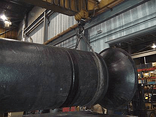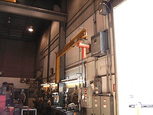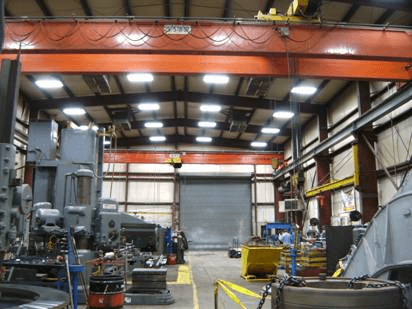Generally, crane and rigging operations involving overhead cranes, gantries, monorails and wall/floor mounted jibs are repetitive activities in manufacturing facilities. In some workplaces they are used to assist in maintenance and fabrication efforts. Here are a few helpful hints to make overhead crane operations safer and more efficient.
- Paint a strip on the floor which indicates the crane hook’s maximum travel perimeter. For an overhead crane this will result in a “box”, and for a wall mounted jib it will look like an “arc” rounding out a piece if pie. Ensure that the CG (center-of-gravity) of each load to be lifted or handled by that crane is in-board of the floor stripe. It will help avoid “dragging” the load to the plumb line of the crane.
- Crane operators should be constantly aware of aerial work
 platforms or ladders that are erected within the travel or swing range of the crane. Ideally, there should be rail stops installed which can help prevent an overhead crane from traveling into an area with a temporary elevated obstruction. It may be necessary to “lock-out/tag-out” a crane and stop operation if there is a reasonable possibility that travel or jib swing contact can be made between the crane and the obstruction.
platforms or ladders that are erected within the travel or swing range of the crane. Ideally, there should be rail stops installed which can help prevent an overhead crane from traveling into an area with a temporary elevated obstruction. It may be necessary to “lock-out/tag-out” a crane and stop operation if there is a reasonable possibility that travel or jib swing contact can be made between the crane and the obstruction. - Before installing new piping, conduit or machinery near a wall/floor mounted jib, ensure that its swing arc won’t make contact with the new equipment. Damage can occur to the jib, hoist and installed equipment in short order. Electrification has occurred when a jib has been allowed to swing into and make contact with a power source. Swing stops must be installed and robust, in order to prevent jib swing contact.
- Hoist hooks need to be parked in designated areas that will avoid contact with rolling stock like forklifts and aerial work platforms that drive through the facility. More than one case has arisen with “a snagged hoist hook” resulting in violent reaction to both the hoist and traveling equipment/personnel.

- Trained and qualified operators are the best defense to “unplanned events”. Whether production or maintenance employees; having competent folks at the controls reduces the potential for accidents significantly. Keep skills up by sponsoring a crane operators’ rodeo and develop some crane control challenges that highlight skills, knowledge and proficiency. Desire to perform well, has many benefits.
Happy trails to my crane and rigging friends,
Mike Parnell
ITI – Field Services




COMMENTS